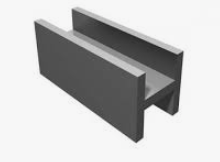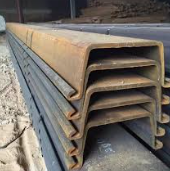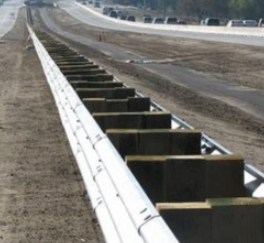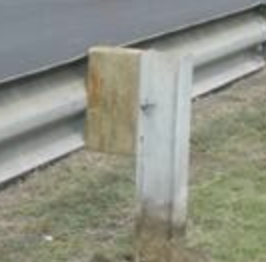Efficient Hydraulic Post Remover Techniques
- Megan Meade
- May 2, 2024
- 10 min read
Updated: May 9, 2024

Key Highlights
The Groundwork Pile Extractor is a compact and versatile hydraulic removal tool capable of generating up to 30, kN of extraction force.
It can easily accommodate most steel 'H' and 'U'-sheet pile sections without any modification.
The process of extracting piles from the earth requires the use of a clamp attached to a hydraulic vibro hammer.
Hydraulic power is supplied by skid steer or 6 - 10 tonne Excavator
The benefits of using hydraulic systems for post removal include efficiency, safety, and speed.
Introduction

Hydraulic post removal has become an essential technique in the construction and infrastructure industries. Whether it's removing sheet piles, rail elements, or damaged guardrails, the efficiency and speed of hydraulic systems have proven to be invaluable. One such hydraulic post removal tool that has gained popularity is the Groundwork Hydraulic Pile Extractor.
The Groundwork Hydraulic Pile Extractor is a revolutionary piece of equipment that provides a solution to the increasing demand for noiseless and vibration-free pile extraction. It offers a compact and versatile design, making it suitable for a wide range of post removal applications. With its impressive extraction force of up to 30 kN , it can handle even the toughest extraction tasks with ease.

The Groundwork Hydraulic Pile Extractor operates on a hydraulic system, which ensures smooth and controlled extraction. The process involves clamping the pile and pulling it out at a rate of up to 1 post per 15 seconds. The hydraulic power is supplied by a skid steer or 6 - 10 tonne Excavator. In this blog, we will explore the basics of hydraulic post removal, the benefits of using hydraulic systems, and provide a step-by-step guide on how to efficiently remove posts using the Groundwork Hydraulic Pile Extractor. We will also address common issues and troubleshooting techniques, as well as share some successful case studies. So, let's dive in and discover the efficient hydraulic post remover techniques!

Understanding Hydraulic Post Removal
Hydraulic post removal is a technique that utilizes hydraulic power to safely and efficiently remove various types of posts. Whether it's sheet piles, rail elements, or guardrail posts, hydraulic systems offer a reliable and controlled method of extraction. By applying hydraulic force, the posts can be clamped and extracted with precision and speed. This technology ensures minimal disruption to the surrounding environment, reduces the risk of damage or vibration, and provides a more efficient alternative to traditional removal methods.
The Basics of Hydraulic Post Removal Technology
Hydraulic post removal technology is based on the principle of utilizing hydraulic power to generate the necessary force for extraction. The system consists of hydraulic cylinders, a power source, and a control system.
To begin the process, the post to be removed is clamped securely using the clamp attached to a skid steer or excavator. The hydraulic power is then applied to generate the extraction force required to pull the post out of the ground. The force is directed in a controlled manner to ensure the post is removed smoothly without causing any damage to the surrounding area.
One of the key advantages of hydraulic post removal technology is that it can be operated from ground level. This eliminates the need for manual labor or specialized equipment to reach the posts, making it a safer and more efficient method of removal. Additionally, the hydraulic power can be easily adjusted to accommodate different types of posts and ground conditions, further enhancing its versatility and effectiveness.

Benefits of Using Hydraulic Systems for Post Removal
Using hydraulic systems for post removal offers several benefits that make it a preferred method in the construction industry. Here are some key advantages:
Efficiency: Hydraulic systems provide a more efficient approach to post removal compared to manual or mechanical methods. The controlled application of hydraulic force ensures quick and precise extraction, minimizing the time and effort required for the process.
Safety: Hydraulic post removal eliminates the need for manual labor and heavy machinery, reducing the risk of accidents and injuries. The controlled operation of hydraulic systems ensures a safer working environment for construction crews.
Speed: Hydraulic systems allow for rapid post removal, enabling construction projects to stay on schedule. The power and speed of hydraulic extraction can efficiently remove posts at a rate of up to 1 post per 15 seconds
Versatility: Hydraulic systems can be adapted to accommodate various types of posts, including sheet piles, rail elements, and guardrails. The adjustable hydraulic power makes it suitable for different ground conditions and post sizes.
Preparing for Hydraulic Post Removal
Before starting the hydraulic post removal process, it is crucial to ensure proper preparation and safety measures are in place. This includes having the necessary safety equipment and conducting a thorough site assessment.
Safety Measures and Equipment Checklist
Safety should be the top priority when it comes to hydraulic post removal. Here are some essential safety measures and equipment to consider:
Safety equipment: Ensure that all workers involved in the post removal process are equipped with proper personal protective equipment (PPE), including hard hats, safety glasses, gloves, and high-visibility vests.
Guardrail post removal: For removing guardrail posts, it is important to follow specific safety protocols to prevent accidents and ensure the safe removal of the posts.
Weight capacity: Check the weight capacity of the hydraulic system and make sure it is suitable for the size and weight of the posts being removed. Exceeding the weight capacity can lead to equipment failure and accidents.
Secure the area: Maintain a safe and clear work area by cordoning off the site and restricting access to authorized personnel only.
Communication: Establish clear communication channels between the operator and the ground crew to ensure smooth coordination during the post removal process.
Ton: Be aware of the extraction force required for the specific post being removed and ensure that the hydraulic system is capable of generating the necessary tonnage.
Site Assessment and Preparation Steps
Before beginning hydraulic post removal, a site assessment should be conducted to identify any potential hazards or obstacles. This assessment ensures that the necessary preparations are made for a smooth and efficient removal process.
The site assessment should include evaluating the ground level and condition, identifying any underground utilities or obstacles, and determining the best approach for removing the posts. For example, if the posts are rail elements, the assessment should take into account any nearby structures or objects that may pose a risk during the removal process.
Once the site assessment is complete, appropriate preparation steps should be taken, such as clearing the work area, marking any underground utilities, and ensuring the hydraulic system is properly set up and calibrated. These measures will help ensure a safe and successful hydraulic post removal process.
Step-by-Step Guide to Hydraulic Post Removal
Setting up the hydraulic post remover involves positioning the Groundwork Hydraulic Pile Extractor at ground level near the post. Ensure the pile is aligned for effective extraction force. Connect the power supply to the hydraulic system and secure all elements with correct spacing. Operate the lever to activate the hydraulics for post extraction. Follow the object markers for attachment alignment. Use the clamp to firmly hold the post before pulling it out using the hydraulic ton power.
Setting Up the Hydraulic Post Remover
Proper setup of the hydraulic post remover is crucial for efficient and safe post removal. The first step is to align the hydraulic post remover with the post to be removed. This ensures that the extraction force is applied directly to the post, minimizing any damage or excessive force on surrounding structures.
Once aligned, it is important to maintain proper spacing between the hydraulic post remover and adjacent posts or objects to prevent any interference during extraction. This spacing ensures that the extraction force is applied solely to the target post, improving the efficiency of the removal process.
The hydraulic power system should be properly connected and activated to provide the necessary force for extraction. This includes ensuring that the hydraulic power systemk is securely connected and the control system is functioning correctly. Regular maintenance and inspection of the hydraulic system are essential to prevent any malfunctions during the removal process.
Operating the Hydraulic System for Efficient Removal
Operating the hydraulic system efficiently plays a crucial role in the effective removal of posts. The puller or lever of the hydraulic post remover is used to engage the post and apply the extraction force. It is important to follow the manufacturer's guidelines and recommendations for using the puller or lever to ensure safe and efficient operation.
Utilizing the full hydraulic power available is also essential for efficient post removal. The skid steer or excavator should be properly maintained and inspected to ensure optimal performance. Regularly checking the hydraulic fluid levels and pressure is important to prevent any loss of power during the extraction process.
Monitoring the extraction process and making necessary adjustments to the hydraulic power will help ensure that the extraction force is applied evenly and effectively. This will result in quicker and more efficient removal of the posts.
Troubleshooting Common Issues in Hydraulic Post Removal
Hydraulic post removal may sometimes encounter common issues that can be easily addressed. Here are two common problems and their solutions:
Problem 1: Hydraulic system failure. This can be caused by a variety of reasons, such as low hydraulic fluid levels or a malfunctioning power supply; The solution is to check and refill the hydraulic fluid if necessary, or troubleshoot and repair any issues with the power supply.
Problem 2: Difficult removal scenarios. Some posts may pose challenges due to their compactness or terminal location. To overcome this, increasing the extraction force or modifying the clamping system may be necessary. Consult the manufacturer's guidelines or seek professional assistance for such situations.
Addressing Hydraulic System Failures
Hydraulic system failures can disrupt the post removal process and result in delays. It is important to address these failures promptly to minimize downtime. Common hydraulic system failures may include low hydraulic fluid levels, malfunctioning hydraulics, or issues with the power supply.
To address low hydraulic fluid levels, check the fluid reservoir and refill it as needed. Ensure that the hydraulic fluid is clean and free from any contaminants that could cause further damage to the system. If the hydraulics are malfunctioning, inspect them for any leaks or damage. Repair or replace the hydraulics as necessary.
In some cases, modifications to the hydraulic system may be required to overcome specific challenges. Consult with the manufacturer or a hydraulic specialist to determine the appropriate modifications for your specific situation. Regular maintenance and inspection of the hydraulic system can help prevent failures and ensure smooth operation during post removal.
Case Studies: Successful Hydraulic Post Removal Projects
Hydraulic post removal has been successfully implemented in various projects. Here are two case studies highlighting the success of hydraulic post removal techniques:
Urban Area Post Removal Challenges and Solutions: In urban areas, posts such as delineators and guardrails often need to be removed. Hydraulic post removers have proven to be effective in safely and efficiently removing these posts without causing damage to surrounding infrastructure. Attachments designed for urban areas, such as object markers, provide additional versatility.
Rural and Remote Location Adaptations: Hydraulic post removal techniques have also been successful in rural and remote locations where accessibility may be limited.
Urban Area Post Removal Challenges and Solutions
In urban areas, the removal of posts such as delineators and guardrails presents unique challenges. These posts are often located in busy or congested areas, requiring careful consideration for the safety of pedestrians, motorists, and nearby structures.
Hydraulic post removers have proven to be highly effective in safely and efficiently removing urban posts. Attachments designed specifically for urban areas, such as object markers, provide additional versatility and ensure precise removal.
The compact size of hydraulic post removers allows for maneuverability in tight spaces, while the hydraulic power ensures a controlled and efficient extraction process. This minimizes the impact on surrounding structures and reduces the risk of damage.
By utilizing hydraulic post removers and specialized attachments, urban area post removal projects can be completed with efficiency, precision, and minimal disruption to the surrounding environment.
Rural and Remote Location Adaptations
In rural and remote locations, the accessibility and availability of resources can pose challenges for post removal projects. However, hydraulic post removers have proved to be adaptable and effective even in such environments.
By utilizing hydraulic post removers in rural and remote areas, posts can be efficiently and safely removed without the need for extensive manual labor or heavy machinery. This significantly reduces project costs and ensures successful post removal in even the most inaccessible locations.
Maintenance and Care for Hydraulic Post Removers
Proper maintenance and care are essential for ensuring the longevity and optimal performance of hydraulic post removers. Here are two key aspects of maintenance and care:
Routine Maintenance Tips: Regularly inspect and clean the hydraulic system, including the cylinders, hoses, and power supply. Check for any leaks, damaged components, or signs of wear. Replace any faulty or worn parts promptly. Lubricate moving parts as recommended by the manufacturer.
Long-term Care Strategies: Establish a maintenance schedule to ensure timely inspections, repairs, and replacements. Keep detailed records of maintenance activities and document any modifications or adaptations made to the hydraulic post remover. Regularly review and update the maintenance schedule to align with the specific needs and usage of the post remover.
By following routine maintenance tips and implementing long-term care strategies, hydraulic post removers can be maintained in optimal condition for future use, ensuring consistent performance and reliability.
Conclusion
In conclusion, mastering efficient hydraulic post removal techniques requires understanding the technology, following safety protocols, and troubleshooting common issues. By utilizing hydraulic systems, you can benefit from increased productivity and precision in post removal projects. Remember to conduct thorough site assessments, adhere to safety measures, and implement proper maintenance for optimal performance. These practices will ensure successful post removal projects in various settings, from urban areas to rural locations. Embracing hydraulic post removal technology equips you with the tools and knowledge needed to tackle diverse post removal challenges effectively.
Frequently Asked Questions
How do you remove driven guardrail posts?
Using specialized hydraulic post removers with attachments designed for guardrail posts ensures efficient removal. Attach the appropriate tool, apply hydraulic pressure to push or pull out the post gently, and clear the area of debris. Always follow safety protocols to prevent accidents.
How to Choose the Right Hydraulic Post Remover for Your Project?
Choosing the right hydraulic post remover for your project requires considering several factors. These include the specific requirements of the posts to be removed (such as sheet pile or rail elements), the available power supply options, the desired extraction force (in tons), and the type of puller or clamp required. Arrange a consultation with Groundworks to determine the best fit for your project.
Can Hydraulic Post Removers be Used on All Types of Posts?
Hydraulic post removers can be used on various types of posts, including sheet pile, rail elements, and guardrails posts.
However, it is essential to consider the specific dimensions and characteristics of the posts, such as their size and location. Hydraulic post removers are typically designed to accommodate a range of post sizes, but it is important to ensure compatibility and safety during the post removal process. Arrange a consultation with Groundworks to determine the suitability for specific post types.












Comments